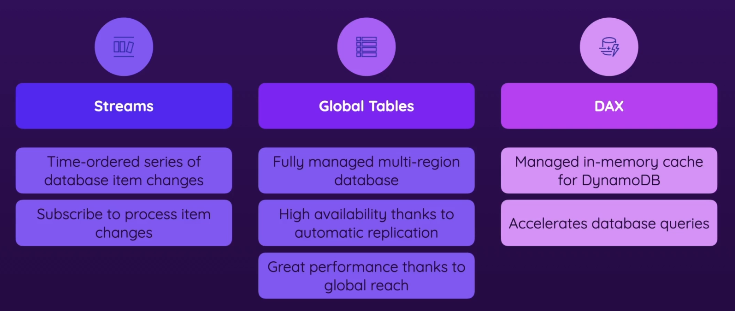DynamoDB
A fully managed, highly scalable NoSQL key-value database that can maintain millisecond latencies at any scale
- Just like RDS Aurora, it’s a database engine built by Amazon
- Important
- You don’t create tables with the query language that you use to talk to the db
- No need to connect to the db to then create tables inside of it
- You NEVER create a db, you JUST create tables!
- Can create many tables as you need, but you don’t group/structure the, into dbs
- No need to worry about db configurations, AWS takes care for you
- A regional service
- ex) A user wants a NoSQL database that can scale to millions of requests per second with single-digit millisecond latency
You create tables
You don’t create instances or clusters unlike RDS or ElastiCache, just start right at the table lvl
- You have to give the table a name
- Partition key
- Main identification key
- specify a primary key that uniquely identifies each item in the table
- should be unique for each item in the table, like an ID
- Choose payment
- Non on demand plan
- Choose expected read/write capacities to define how much you’re gonna pay for
- On demand
- you only pay for the occurring read/writes, more expensive but more flexibility
- Non on demand plan
- Choose encryption settings on a table basis
- Once a table is created/configured
- start managing data
- write/read data with the SDK
- no general query language, but u need to use AWS tools to interact
- configure backups for the data
Advanced Features
- diagram

- Streams
- DynamoDB Streams is essentially a log of changes (additions, updates, and deletions) made to items in a DynamoDB table
- not enabled by default
- allows you to capture changes to items in your DynamoDB table and make these changes available for other systems to process or take action upon
- useful when you need to react to data changes (like additions, updates, or deletions) in real-time without polling the database constantly
- kinda reminds me of React!
- After enabling Streams, other systems or applications can subscribe to the stream and be notified whenever there is a change.
- Global tables
- A Global Table is a special type of DynamoDB table that spans multiple AWS regions. It automatically replicates the data between these regions.
- You can convert a table from one region into a global table
- makes it available with low-latency access for users anywhere in the world
- Not free (and can get quite expensive)
- Click table > create replica
- DAX
- Database Acceleration feature
- A managed in-memory cache layer, fully managed by AWS
- does come at a price